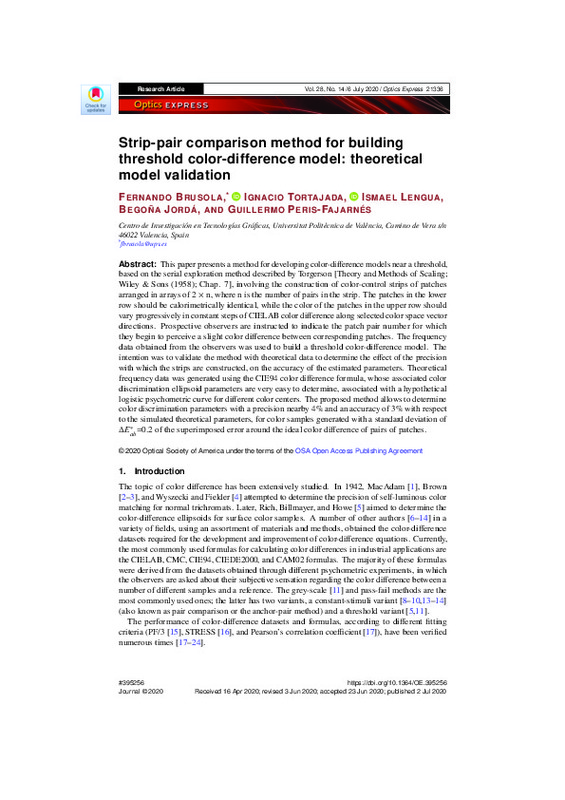JavaScript is disabled for your browser. Some features of this site may not work without it.
Buscar en RiuNet
Listar
Mi cuenta
Estadísticas
Ayuda RiuNet
Admin. UPV
Strip-pair comparison method for building threshold color-difference model: theoretical model validation
Mostrar el registro sencillo del ítem
Ficheros en el ítem
| dc.contributor.author | Brusola Simón, Fernando
|
es_ES |
| dc.contributor.author | Tortajada Montañana, Ignacio
|
es_ES |
| dc.contributor.author | Lengua, Ismael
|
es_ES |
| dc.contributor.author | Jorda-Albiñana, Begoña
|
es_ES |
| dc.contributor.author | Peris Fajarnes, Guillermo
|
es_ES |
| dc.date.accessioned | 2021-11-05T14:12:18Z | |
| dc.date.available | 2021-11-05T14:12:18Z | |
| dc.date.issued | 2020-07-06 | es_ES |
| dc.identifier.issn | 1094-4087 | es_ES |
| dc.identifier.uri | http://hdl.handle.net/10251/176498 | |
| dc.description.abstract | [EN] This paper presents a method for developing color-difference models near a threshold, based on the serial exploration method described by Torgerson [Theory and Methods of Scaling; Wiley & Sons (1958); Chap. 7], involving the construction of color-control strips of patches arranged in arrays of 2 x n, where n is the number of pairs in the strip. The patches in the lower row should be calorimetrically identical, while the color of the patches in the upper row should vary progressively in constant steps of CIELAB color difference along selected color space vector directions. Prospective observers are instructed to indicate the patch pair number for which they begin to perceive a slight color difference between corresponding patches. The frequency data obtained from the observers was used to build a threshold color-difference model. The intention was to validate the method with theoretical data to determine the effect of the precision with which the strips are constructed, on the accuracy of the estimated parameters. Theoretical frequency data was generated using the CIE94 color difference formula, whose associated color discrimination ellipsoid parameters are very easy to determine, associated with a hypothetical logistic psychometric curve for different color centers. The proposed method allows to determine color discrimination parameters with a precision nearby 4% and an accuracy of 3% with respect to the simulated theoretical parameters, for color samples generated with a standard deviation of Delta E*(ab)=0.2 of the superimposed error around the ideal color difference of pairs of patches. | es_ES |
| dc.language | Inglés | es_ES |
| dc.publisher | The Optical Society | es_ES |
| dc.relation.ispartof | Optics Express | es_ES |
| dc.rights | Reconocimiento (by) | es_ES |
| dc.subject | Color | es_ES |
| dc.subject | CIELAB | es_ES |
| dc.subject | Color-difference models | es_ES |
| dc.subject | Color-control strips | es_ES |
| dc.subject | Patches | es_ES |
| dc.subject | Calorimetrically | es_ES |
| dc.subject | Constant | es_ES |
| dc.subject | Observers | es_ES |
| dc.subject.classification | EXPRESION GRAFICA EN LA INGENIERIA | es_ES |
| dc.subject.classification | DIBUJO | es_ES |
| dc.title | Strip-pair comparison method for building threshold color-difference model: theoretical model validation | es_ES |
| dc.type | Artículo | es_ES |
| dc.identifier.doi | 10.1364/OE.395256 | es_ES |
| dc.rights.accessRights | Abierto | es_ES |
| dc.contributor.affiliation | Universitat Politècnica de València. Departamento de Ingeniería Gráfica - Departament d'Enginyeria Gràfica | es_ES |
| dc.description.bibliographicCitation | Brusola Simón, F.; Tortajada Montañana, I.; Lengua, I.; Jorda-Albiñana, B.; Peris Fajarnes, G. (2020). Strip-pair comparison method for building threshold color-difference model: theoretical model validation. Optics Express. 28(14):21336-21347. https://doi.org/10.1364/OE.395256 | es_ES |
| dc.description.accrualMethod | S | es_ES |
| dc.relation.publisherversion | https://doi.org/10.1364/OE.395256 | es_ES |
| dc.description.upvformatpinicio | 21336 | es_ES |
| dc.description.upvformatpfin | 21347 | es_ES |
| dc.type.version | info:eu-repo/semantics/publishedVersion | es_ES |
| dc.description.volume | 28 | es_ES |
| dc.description.issue | 14 | es_ES |
| dc.identifier.pmid | 32680177 | es_ES |
| dc.relation.pasarela | S\418503 | es_ES |








